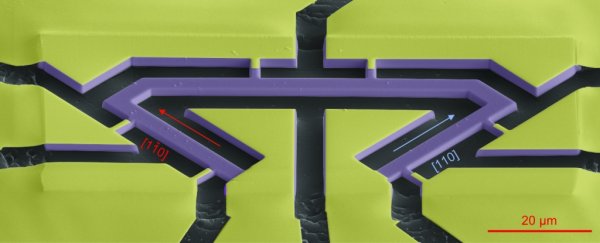When they're just hanging out in most metals, electrons are pretty chill. They move about individually and freely to conduct heat and electricity.
But in some rare situations, it turns out they can start moving together as a group. And that weird effect has been spotted taking place in a piece of antiferromagnetic superconducting material forced into a state of matter somewhere between being a liquid and a crystal.
The team from the Max Planck Institute for Chemical Physics of Solids used a compound made of layered cerium, rhodium and indium (CeRhIn5), cut with microscopic conducting paths with a focused ion beam.
When a strong magnetic field of over 30 tesla is applied, the electrons start flowing together in the same direction.
This phase of matter is called 'electronic nematic', a state between liquid and crystal.
"It's sort of like in ancient times," said principal investigator Phillip Moll. "People would draw maps in whatever direction best served them. But this state is like the moment when the world's mapmakers unified to arbitrarily pick north as the orientation for all maps."
Scientists believe electronic nematicity and superconductivity are closely related. In both states, electrons flow without resistance. Electronic nematicity has also been observed in other superconducting materials, such as iron-based and copper-based compounds.
However, in previous experiments, the two states could not be created independently from each other, so researchers could not determine the relationship between electronic nematicity and superconductivity — whether they are dependent on each other, cooperative, or unrelated.
With the CeRhIn5 crystal, the two states could be triggered independently. When placing the crystal under high pressure, it demonstrates superconductivity. When placing it in a 45 tesla magnetic field, it demonstrates electronic nematicity. By tuning the pressure and magnetic field, the team could fluctuate the states.
This means it could be uniquely placed to study possible interactions between the two states.
"This fundamental question in materials in which the electrons interact was the starting point for my PhD thesis," said doctoral student and researcher Maja Bachmann.
"Do the electrons have to decide either to pair or to all go in one direction? In other words, are superconductivity and nematicity competitive phenomena, or could the same interaction that leads to pairing also create nematicity?"
The next step in the research is to try and induce both states simultaneously, and observe how one state merges into another.
"We have the knob to tune both nematicity and superconductivity, and play with these states to see how they interact with one another," researcher Toni Helm told IOP Physics World.
"This makes our work unique."
The research has been published in the journal Nature.
